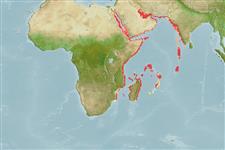>
Mulliformes (Goatfishes) >
Mullidae (Goatfishes)
Etymology: Parupeneus: Latin, parum, parvum = small + Peneus, the name of a river.
More on authors: Randall & Guézé.
Environment: milieu / climate zone / depth range / distribution range
Écologie
marin récifal; profondeur 1 - 55 m (Ref. 54393). Tropical
Western Indian Ocean: Persian Gulf and the Gulf of Oman to western Pakistan.
Taille / Poids / Âge
Maturity: Lm ? range ? - ? cm
Max length : 23.0 cm TL mâle / non sexé; (Ref. 11441)
Description synthétique
Clés d'identification | Morphologie | Morphométrie
Épines dorsales (Total) : 8; Rayons mous dorsaux (Total) : 9; Épines anales: 1; Rayons mous anaux: 7; Vertèbres: 24. Diagnosis: Pectoral rays 15-17 (usually 16). Gill rakers 6-8 + 22-25 (total 29-33). Body moderately elongate, the depth 3.5-4.05 in SL (to 4.35 in juveniles); head length (HL) 2.75-3.0 in SL; snout length 1.75-2.3 in head length; upper-jaw length 3.0-3.5 in HL; barbels relatively short, 1.4-1.65 in HL; third dorsal spine longest, 1.65-1.95 in HL; last dorsal soft ray only slightly longer than penultimate ray; pectoral-fin length 1.5-1.7 in HL; pelvic-fin length 1.5-1.8 in HL. Gray to brownish red dorsally, whitish to light red ventrally, with a small pearly white to pale blue spot on each scale of body below the lateral line (center of scales on body above lateral line whitish but not as a distinct spot); an elongate white spot anteriorly on upper side of caudal peduncle, sometimes followed by a dusky spot of about the same size; a brown band on snout from upper lip to eye, often continuing onto postorbital head and narrowly a short distance onto body (band usually not persisting in preservative) (Ref. 54393).
Occurs on open sand or silty sand bottom or on sand and rubble in the vicinity of reefs or rocky outcrops (Ref. 54393).
Life cycle and mating behavior
Maturité | Reproduction | Frai | Œufs | Fécondité | Larves
Randall, J.E., 2004. Revision of the goatfish genus Parupeneus (Perciformes: Mullidae), with descriptions of two new species. Indo-Pac. Fish. (36):64 p. (Ref. 54393)
Statut dans la liste rouge de l'IUCN (Ref. 130435: Version 2024-1)
Menace pour l'homme
Harmless
Utilisations par l'homme
Pêcheries:
Outils
Articles particuliers
Télécharger en XML
Sources Internet
Estimates based on models
Preferred temperature (Ref.
123201): 25.5 - 29.3, mean 27.3 °C (based on 238 cells).
Phylogenetic diversity index (Ref.
82804): PD
50 = 0.5000 [Uniqueness, from 0.5 = low to 2.0 = high].
Bayesian length-weight: a=0.01175 (0.00543 - 0.02542), b=3.10 (2.93 - 3.27), in cm total length, based on LWR estimates for this Genus-body shape (Ref.
93245).
Niveau trophique (Ref.
69278): 3.4 ±0.4 se; based on size and trophs of closest relatives
Résilience (Ref.
120179): Haut, temps minimum de doublement de population inférieur à 15 mois (Preliminary K or Fecundity.).
Fishing Vulnerability (Ref.
59153): Low vulnerability (13 of 100).
Nutrients (Ref.
124155): Calcium = 45.6 [21.7, 105.3] mg/100g; Iron = 0.344 [0.174, 0.796] mg/100g; Protein = 17.9 [14.5, 20.9] %; Omega3 = 0.135 [0.075, 0.244] g/100g; Selenium = 48.2 [22.5, 116.8] μg/100g; VitaminA = 232 [45, 991] μg/100g; Zinc = 0.597 [0.348, 1.126] mg/100g (wet weight);
